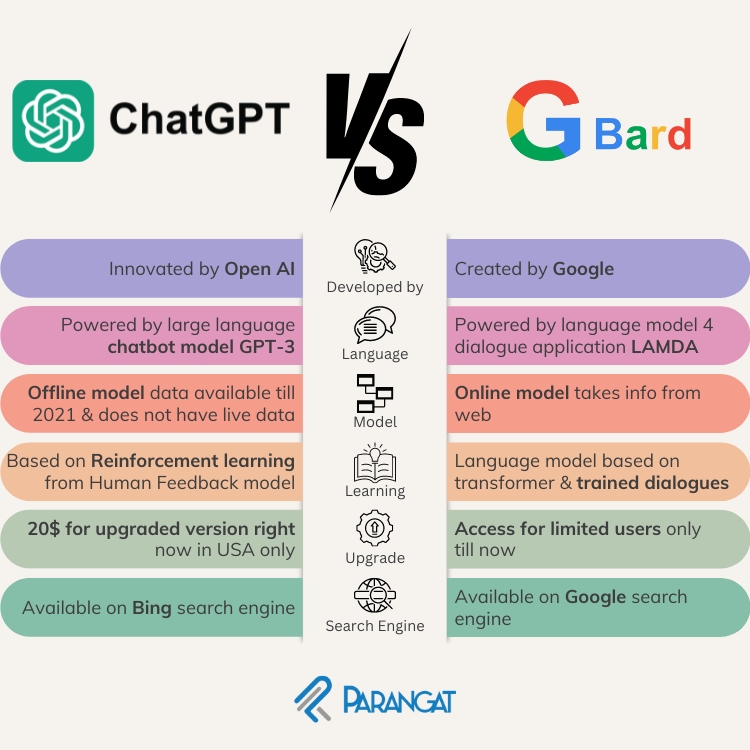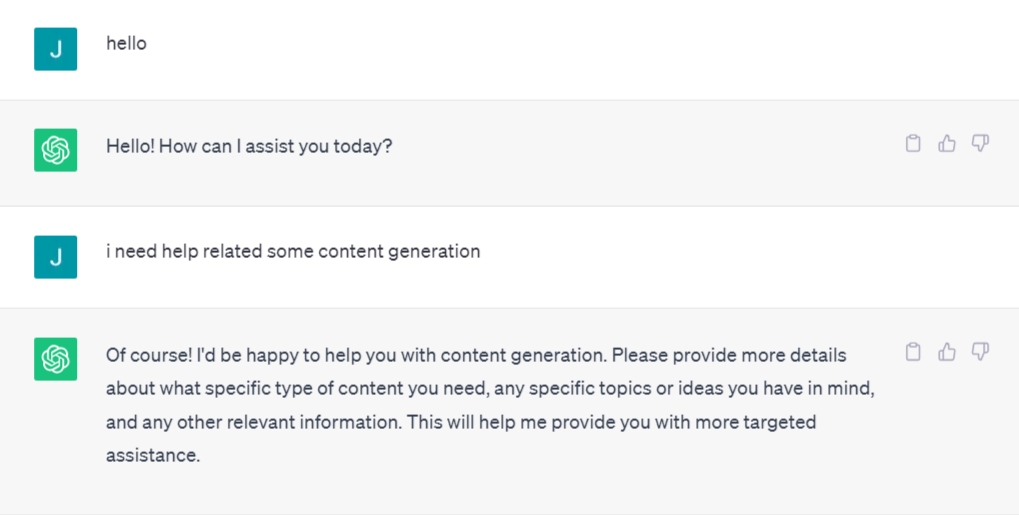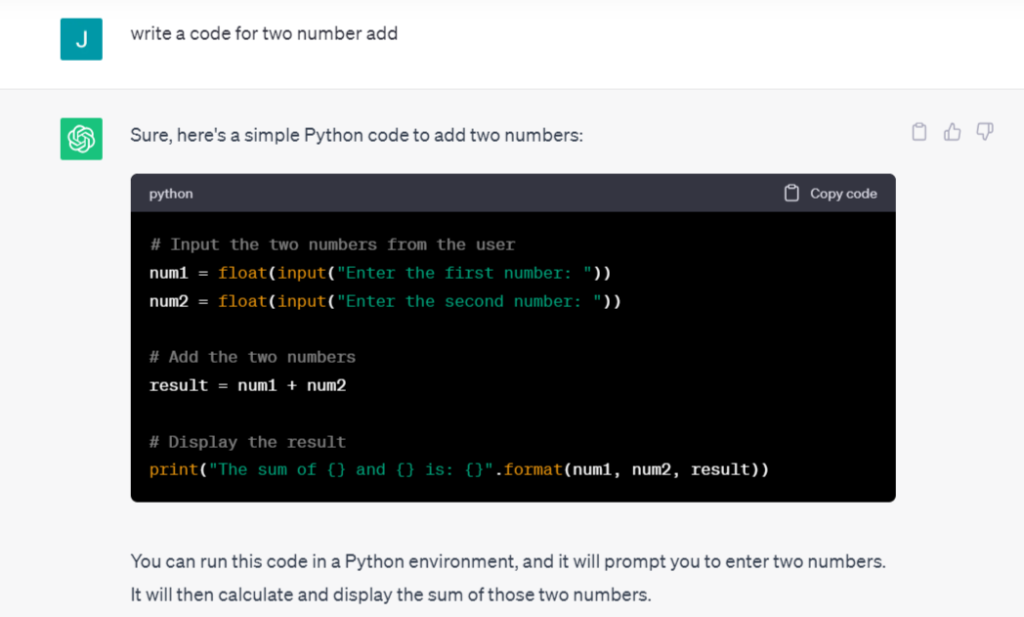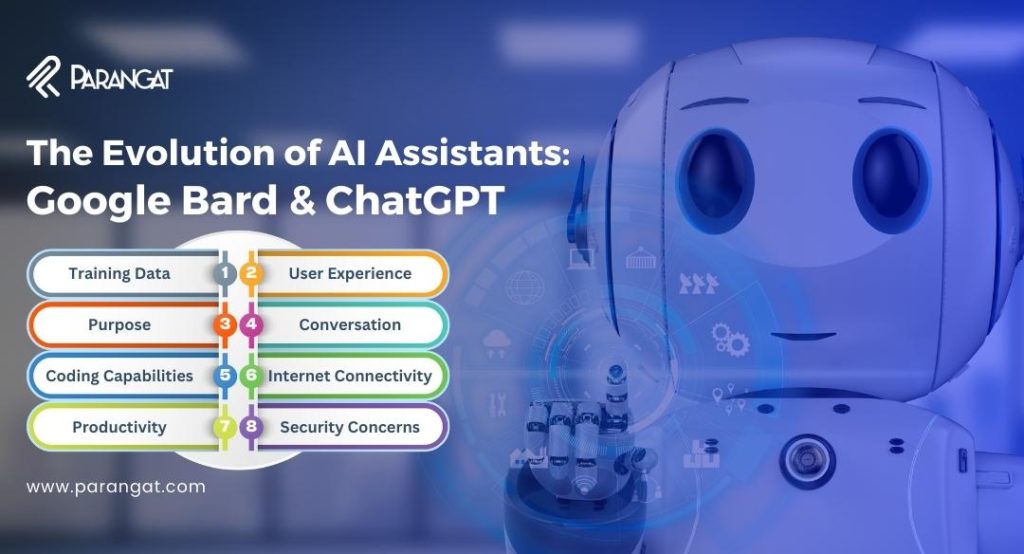AI is the talk of the town, and it is more than a passing trend. In fact, research shows the flourishing future of AI. The market is estimated to reach $1.85 trillion by 2030. It has been making waves in the sector with no signs of ceasing. New tools and technologies continuously evolve to dominate the Artificial Intelligence market and push the boundaries of what is possible in interactions.
Remember when OpenAI introduced ChatGPT and turned into an internet sensation in 2022? It became so trendy that there were one million users within its first five days. Moving ahead, it set a record for the fastest application to gain 100 million users in only two months. It disrupted every industry you can think of, and organizations readily implemented the novel technology to avail of its benefits. Google, however, suffered the heat as many questioned the renowned search engine. ChatGPT presented a quicker and more focused search with faster results; of course, it left the future of the search ad engine hanging. And guess what Google did? It launched its own iteration of ChatGPT in 2023 for free!
Google Bard vs. ChatGPT has been a heated discussion for a long time. Both the AI chatbots generate responses to prompts. You can use ChatGPT and Bard for content creation, production, development, and more. But which one is the best for you? This article aims to give an in-depth comparison between two popular AI tools. So, dive in!
ChatGPT Vs. Google Bard: At A Glance
ChatGPT and Bard are a couple of several examples of generative AI. These tools allow you to enter written prompts and receive innovative human-like texts or images. Both chatbots are similar on the surface. The primary difference between ChatGPT and Bard is the data sources employed to train the LLMs powering them. PaLM 2 uses data chosen to enhance its dialogue and coding capabilities. In addition, the chatbot has real-time access to the internet. On the other hand, ChatGPT has not been updated since 2021 and uses a predefined data set.
Before delving into the notable differences in depth, here is a quick overview of how Google Bard and ChatGPT compare:
|
S.No. |
Aspect |
ChatGPT |
Bard AI |
|
1. |
Creator | OpenAI (Microsoft) | |
|
2. |
Release Date | 30th November 2022 | 21st March 2023 |
|
3. |
Data Sources | Pre-trained on a large data set, including Common Crawl, books, articles, and Wikipedia. | It utilizes data from webpages, source codes, and other datasets. It can search the web in real-time to provide the latest information. |
|
4. |
Language Model | GPT-3.5/GPT-4, depending on the version | Pathways Language Model (PaLM 2) |
|
5. |
Pricing | Free; ChatGPT Plus costs $20 per month | Free to all users |
|
6. |
Sign In | Requires an email address | A Google account to sign in |
You can use ChatGPT and Bard to ask complex and multi-faceted queries. The mentioned differences in their build lead to varied results and set them apart.
What Is ChatGPT?
ChatGPT stands for Chat Generative Pre-trained Transformer. It is an advanced AI chatbot that employs the machine learning framework to communicate and give intuitive answers. The platform is based on the foundations of GPT-3.5 architecture. ChatGPT excels at generating human-like text responses. It can be an effective conversational partner for users seeking helpful and informative answers. ChatGPT provides diverse support across numerous topics, catering to a range of user needs. Some primary features include:
Interactive Responses
ChatGPT operates on Reinforcement Learning with the Human Feedback model. It can generate personalized and engaging responses.
- Multilingual: The model is trained on text data from different languages. Hence, it can generate answers in multiple languages, including English, Spanish, French, and German.
- Integration with Plugins: ChatGPT lets you connect with thousands of applications. This way, you can automate your tasks and work on core activities.
- Pricing: Although ChatGPT is free to use, it has a limit of 100 questions daily. ChatGPT Plus AI costs $20 per month and offers faster responses and access to GPT-4.
What Is Google Bard?
Google Bard is an AI-powered chatbot. It uses natural language processing and machine learning to simulate human conversations and draws responses from the internet. It initially leveraged LaMDA for dialogue applications but upgraded to PaLM 2. The chatbot mimics humans and can perform functions like math, logic, and code. It strives to blend expansive knowledge with the capabilities of large language models.
Google views Bard as an experiment and continues to present it in a Beta form. Here are a few of its features:
- Spoken Responses: Google Bard provides voice-based interactions. It enables you to use the tool as a voice assistant.
- Synchronization with Google Products: Bard is compatible with various Google products. You can integrate it with Google Sheets, Slides, and Docs to make presentations and spreadsheets.
- Personalization: It allows you to tailor responses, such as professional, simple, creative, or casual, per your preferences.
- Pricing: Bard is available in 180 countries for free. You only need a Google account to access the platform.
ChatGPT Vs. Google Bard: Key Differences
ChatGPT is a conversational AI tool, while Bard proclaims itself an experiment. Which one of them is bringing more to the table? Each platform has its unique benefits and limitations. However, multiple factors distinguish them and dictate how to use them to make the most out of their offerings.

1. Training Data
Not much is there about Bard’s training data. It has been trained on Infiniset of data chosen to enhance its dialogue. A LaMDA research highlights that it sources about 12.5% of the training data from Common Crawl and another same percentage from Wikipedia. Meanwhile, ChatGPT runs on an unrevealed data set up to 2021. It boasts more model parameters than the former, with 175 billion than 137 billion. The parameters allow the models to adjust and adapt to the data during training. Although more parameters indicate better synthesis of complex language relationships, they can also risk overfitting. Overall, both AI tools have their positives. Bard shows greater resilience to novel language use cases, whereas ChatGPT is more versatile.
2. User Experience
Using ChatGPT and Bard is a breeze. You have to type in your queries; the bots will deliver answers. These platforms are very straightforward. It is impossible to make a mistake when inputting prompts. Consequently, finding the required answers is a piece of cake! However, Bard is miles ahead of ChatGPT in its interface. Not only is it user-friendly and appealing, but it also allows you to edit your questions once you run the prompt. That is not it; it even prepares multiple responses and formats them in a way easier to scan and read. You can use images and receive answers to your prompts with videos and graphics. Bard can also translate text and speech and offer answers in different languages.
3. Purpose
ChatGPT is the industry standard for natural language tasks and powers tools like Bing’s AI tool, Jasper, and Copy.ai. It is well capable of generating text based on statistical patterns. Although it works as a chatbot, it can serve as a translator, summarizer, and other roles on a textual level.
ChatGPT is also better at creating blogs, brainstorming marketing ideas, and long-form emails and articles. However, you may need to adjust and train your model on a particular data set to optimize its performance for a specific task. Bard, however, can be helpful when you use it for concise answers around any topic. You need not click through ten web pages to get the desired information. Bard will scour through multiple pages and summarize for you. You can add a website link to the prompt and ask Bard to summarize the same. It will give spot-on results and highlight the significant details using images to make the content more interactive.
4. Conversation
Bard is one chatty assistant. Therefore, it should be your go-to tool when you are in the mood for small talk! While ChatGPT is all business, you can expect more human and engaging responses from Bard. For instance, when you ask the chatbots whether they are sentient, ChatGPT answers a definitive no. Meanwhile, Bard expresses its uncertainty and cites the philosophical debates about the meaning of sentience.

ChatGPT sticks to the facts (pre-2021) and seems more thoughtful regarding complex ethical queries. Bard vaguely responds to subjective questions and offers more conversational and in-depth answers. It also articulates the text better and makes it easy to read rather than presenting chunky paragraphs like ChatGPT. However, there is also a downside. Bard does not keep track of your previous conversations. ChatGPT has an edge as it shows your queries in the side panel. You can share those conversations with your colleagues or friends for a collaborative experience.
5. Coding Capabilities
Say you ask ChatGPT or Bard to generate a piece of code for something, and it spits out dozens of lines of code in seconds. Easy, yes? But what are the odds that the code works? Let’s assume the code works, but how good is it? ChatGPT can provide programming guidance, answer questions, and assist with code-related inquiries, to make coding more efficient and accessible. It includes various programming languages, frameworks, and coding styles and offers context-aware coding responses.

The new features in Bard enable code generation, debugging, and providing explanations. Google claims you can ask Bard to create or optimize existing code for speed and efficiency. In addition, the chatbot can correct broken code, including its own, if it encounters any issues. ChatGPT and Bard are beneficial in many ways. But you must assume their reliability and accuracy to be experimental at best. A fact that Google Bard makes very clear in its onboarding experience.
6. Internet Connectivity
Accuracy is among the crucial factors when using AI tools. It does not matter whether you have perfected the art of writing discernible prompts to receive correct responses. The dataset in ChatGPT allows it to offer information until September 2021. ChatGPT learns from the conversations you have with the bot. You have to pay for the Plus version to access the web for more precise answers. Unfortunately, it may take longer to generate results even then. Google Bard steals the points here due to its ability to facilitate real-time data. It can easily curate answers to questions, like what is trending on the internet today. Further, each response has a CTA, Google it, to enable you to confirm the sources. Another perk Bard offers is drafts features. You can view variations of responses and visit the citations and references used in an answer.
7. Productivity
Google Bard and ChatGPT can give a hand in the workplace. More than 90% of employees are troubled with recurring and tedious tasks. AI chatbots can help you perform social media posts, blog posts, drafting emails, and product descriptions. Besides alleviating the needless burden, AI tools will make your employees more productive. You can utilize Bard to store notes and documents and retrieve them whenever needed. It is also good at summarizing transcripts of lectures, speeches, and meetings. It can help you focus on your work by reminding you to take short breaks and blocking distractions.
ChatGPT is more creative. It can assist you in scheduling meetings, sending reminder emails, drafting agendas, and responding to project-related concerns. It can also provide outlines or ideas for marketing campaigns and tricks to promote your product. Google Bard and ChatGPT have capabilities to ease and streamline your work process. However, you must know which tool to use for a specific task to attain better results.
8. Security Concerns
Online security and safety are critical concerns when using AI-powered tools. None of the tools is that great. Bard and ChatGPT are highly invasive and have robust access to sensitive information. Further, they have little control over any data you input into their system. ChatGPT employs a reactive security approach. It addresses issues when they arise rather than proactively preventing them. A quick tip? Refrain from telling it anything you would not want the world to know!
Read More About:- Super AI
ChatGPT And Google Bard: Who Is Better?
In conclusion, the debate between ChatGPT and Google Bard ultimately comes down to individual preferences and specific use cases. Both AI systems have their strengths and weaknesses, with ChatGPT excelling in natural language understanding and Google Bard showcasing impressive creative writing capabilities. Choosing the better option depends on the unique requirements of your project or task. However, it’s important to note that the ChatGPT company, as a pioneer in AI language models, has been at the forefront of AI development, and collaborating with a ChatGPT development company could offer tailored solutions for various industries. Ultimately, the choice between ChatGPT and Google Bard should be made based on your specific needs and goals. Parangat is a leading AI software development company committed to providing top-grade services. We offer fine-tuned advanced AI solutions to help you streamline operations and increase efficiency

With roll up sleeves, dive in and get the job done approach, it was in the year 2010 when Sahil started Parangat Technologies. Emphasizing a healthy work culture and technology-driven company, he has successfully created a workplace where people love to work and live. He is a software engineer and a passionate blockchain enthusiast.


 +44-7511-112566
+44-7511-112566 +353-1-8079571
+353-1-8079571 +1-415-799-9792
+1-415-799-9792

